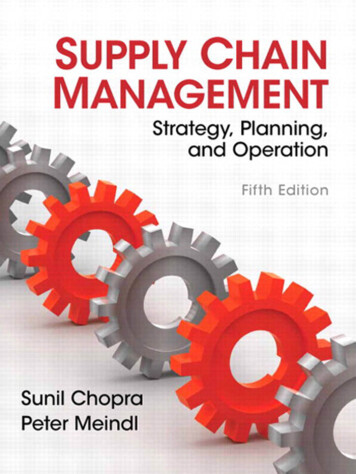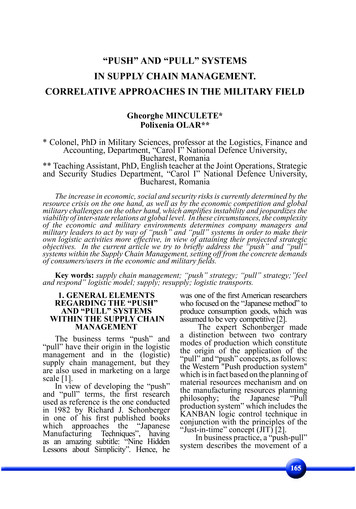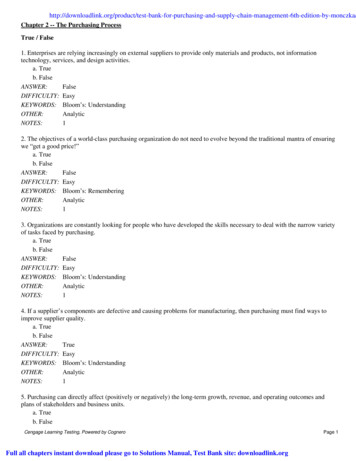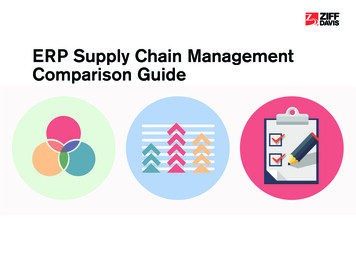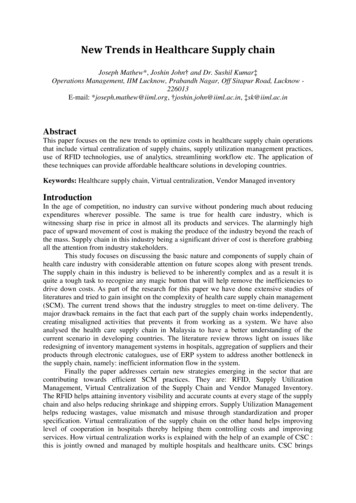
Transcription
New Trends in Healthcare Supply chainJoseph Mathew*, Joshin John† and Dr. Sushil Kumar‡Operations Management, IIM Lucknow, Prabandh Nagar, Off Sitapur Road, Lucknow 226013E-mail: *joseph.mathew@iiml.org, †joshin.john@iiml.ac.in, ‡sk@iiml.ac.inAbstractThis paper focuses on the new trends to optimize costs in healthcare supply chain operationsthat include virtual centralization of supply chains, supply utilization management practices,use of RFID technologies, use of analytics, streamlining workflow etc. The application ofthese techniques can provide affordable healthcare solutions in developing countries.Keywords: Healthcare supply chain, Virtual centralization, Vendor Managed inventoryIntroductionIn the age of competition, no industry can survive without pondering much about reducingexpenditures wherever possible. The same is true for health care industry, which iswitnessing sharp rise in price in almost all its products and services. The alarmingly highpace of upward movement of cost is making the produce of the industry beyond the reach ofthe mass. Supply chain in this industry being a significant driver of cost is therefore grabbingall the attention from industry stakeholders.This study focuses on discussing the basic nature and components of supply chain ofhealth care industry with considerable attention on future scopes along with present trends.The supply chain in this industry is believed to be inherently complex and as a result it isquite a tough task to recognize any magic button that will help remove the inefficiencies todrive down costs. As part of the research for this paper we have done extensive studies ofliteratures and tried to gain insight on the complexity of health care supply chain management(SCM). The current trend shows that the industry struggles to meet on-time delivery. Themajor drawback remains in the fact that each part of the supply chain works independently,creating misaligned activities that prevents it from working as a system. We have alsoanalysed the health care supply chain in Malaysia to have a better understanding of thecurrent scenario in developing countries. The literature review throws light on issues likeredesigning of inventory management systems in hospitals, aggregation of suppliers and theirproducts through electronic catalogues, use of ERP system to address another bottleneck inthe supply chain, namely: inefficient information flow in the system.Finally the paper addresses certain new strategies emerging in the sector that arecontributing towards efficient SCM practices. They are: RFID, Supply UtilizationManagement, Virtual Centralization of the Supply Chain and Vendor Managed Inventory.The RFID helps attaining inventory visibility and accurate counts at every stage of the supplychain and also helps reducing shrinkage and shipping errors. Supply Utilization Managementhelps reducing wastages, value mismatch and misuse through standardization and properspecification. Virtual centralization of the supply chain on the other hand helps improvinglevel of cooperation in hospitals thereby helping them controlling costs and improvingservices. How virtual centralization works is explained with the help of an example of CSC :this is jointly owned and managed by multiple hospitals and healthcare units. CSC brings
together geographically dispersed healthcare units together and allows them to work togetherto attain maximum efficiencies in procurement, contracting and customer service.Presently hospitals are looking for new sources of competitive advantage and costcutting measures wherever possible. It is imperative to look into the supply chainmanagement aspects and identify areas in which they can improve the quality of service forefficient patient care. Supply Chain Management in healthcare should ensure complete endto-end visibility of information among suppliers, manufacturers, distributors and customers.The healthcare supply chain involves the flow of many different product types and theparticipation of several stakeholders. The main purpose of the healthcare supply chain is todeliver products in a timely manner, in order to fulfill the needs of providers. Based on theirfunctions, stakeholders in the healthcare supply chain can be divided into three major groups:producers, purchasers, and providers. (Figure 1)Figure 1: Healthcare supply chain configuration (Adapted from Burns 2002)To add to the complexity of the system, there is also the involvement andparticipation of governmental institutions, regulatory agencies, and insurance companies(Ryan 2005).Primary manufacture involves the creation of the active ingredient contained withinthe medication. Because of the need to avoid contamination between products, there are longdowntimes in production to allow for cleaning, leading to batch production (Shah 2004). Ineffect, this represents mass production. Secondary production sees the active ingredientconverted into useable products (such as tablets, capsules, etc.) This can potentially lead to asignificant expansion in the number of product lines, especially once packaging is taken intoconsideration. Altricher and Caillet (2004) suggest 200 times growth in products across thisstage in the supply chain. With increasing globalisation in the pharmaceutical industry, thelocation of manufacturing plants is often influenced by factors such as tax benefits(Papageorgiou 2001). Indeed, secondary manufacturing may be geographically separatedfrom primary manufacturing and serve local or regional markets (Shah 2004).Turning to the distribution of finished products, there are a number of differentchannels to the market. The dominant intermediary (in terms of volume at least) is thewholesaler. In the UK, approximately 80 per cent of volume flows through this channel (Shah2004). Hospitals and retailers which have large demand requirements receive shipments2 Page
direct from the manufacturers distribution centre. Equally, hospitals may leverage economiesof scale by consolidating their purchasing power through, for example, Group PurchasingOrganisations (Roark 2005).In terms of the characteristics of these supply chains, Shah (2004) provides detailedinformation with regards to typical performance levels. There are long lead times, withproducts taking between 1,000 and 8,000 hours to pass through the whole supply chain.Coupled with this, inventory levels appear quite high with stock turns taking between one andeight weeks. This is consistent with the findings of Haavik (2000) who reported that, in 1994,stock turns in hospital store rooms lasted four to five weeks. Another theme raised by severalauthors is demand amplification (Corrêa 2004, Shah 2004). Given the number ofintermediaries within the supply chain, and the presence of batching within primarymanufacturing, this should perhaps be expected.The product flow (Figure 2) in the healthcare sector starts with the manufacturer andends with the final customer at the healthcare provider. Depending on its type, a product canbe directly delivered by the manufacturer to the healthcare provider, or channelled through adistributor before reaching the healthcare provider. The healthcare supply chain is frequentlydescribed as highly fragmented and relatively inefficient (Schneller and Smeltzer 2006). Amajor problem with the traditional healthcare supply chain is that each stage of the supplychain operates independently, leading to misaligned incentives and conflicting goals thatprevent the supply chain from operating as a system. These conflicting goals, along withother barriers, have hindered the adoption and implementation of SCM practices.HospitalDistribution ormation FlowFigure2: HealthcareProduct FlowProductFlowNursing sOfficeLiterature on Supply Chain Management Practices in the HealthcareSectorThe following literature reviews portray the current status of the healthcare sector relative tobarriers and practices for implementation of SCM principles.Heinbuch (1995) described an approach to meeting the challenge of healthcare costreduction through the hospital material management function. The work highlights the valueof taking a proactive stance to meet the challenge of transferring technology across industrysectors.Alverson (2003) discussed the importance of disciplined inventory management forhospitals, and suggested serious consequences of traditional hospital purchasing includinglack of inventory control, missed contract compliance, excess inventory levels, frequent3 Page
stock-outs and costly emergency deliveries, workflow interruptions, expensive rework, andincreased health system labor requirements.The literature on information technology (IT) provides some solutions to materialmanagement in the healthcare sector. Burns (2002) discussed aggregation of suppliers andtheir products through electronic catalogues, visibility of orders and materials, and efficiencyin procurement.Schneller and Smeltzer (2006) suggested that e-procurement systems can help tosignificantly reduce purchasing costs through the consolidation of supplier networks andcreation of supplier partnerships. They also suggested that transaction and administrationcosts can be reduced through the use of ERP systems, which provide an automated andpaperless format for information to flow throughout an organization.Current state of SCM in Healthcare industryWithin the healthcare industry, the supply chain associated with pharmaceutical products iscritical in ensuring a high standard of care for patients and providing adequate supplies ofmedication for pharmacies. In terms of cost, it is estimated that supply accounts for 25-30percent of operational costs for hospitals (Roark 2005). Therefore, it is essential that this ismanaged effectively to ensure both service and cost objectives are met. Various issuesexisting at the distribution element, particularly from the wholesaler to the hospital are asfollows:Product life cycle: Once the active ingredient is patented, it may take eight years to developthe product into something that can be marketed (Papageorgiou 2001). Once the patentexpires, alternative products may enter the market, or companies may reduce the productprice (Lauer 2004). New technology is shortening life cycles creating new pressures on thedistribution channels.Profit margins: Despite pharmaceutical products having a high value per unit, operatingmargins are small in the wholesaler sector particularly. One cause of this is the control overpricing held by hospitals, retailers and manufacturers (Lauer 2004).Forecasting: It is difficult to predict the exact demand for medicines. One of the issues is theavailability of accurate data on consumption. However, the lack of standard nomenclature forhealthcare products, plus the preferences of clinicians creates further uncertainties (Lauer2004).Lack of supply chain education: Awareness of the concept of supply chain management,particularly within hospitals, is low (Lauer 2004). Therefore, managers are not properlyequipped to control the supply of medication.Given this context, a number of initiatives have been undertaken over recent yearswith a view to reducing supply chain costs and improving customer service. Initialimprovements have been based around implementing just-in-time (JIT) approaches(Kowalski 1986). Subsequently, this has been developed further with the introduction ofstockless inventory systems (Wilson 1992). The JIT and stockless approach can reduceinventory holding costs in the organization, while maintaining service levels (Lynch 1991).More recently, it has been suggested that the stockless system should only be used for highvolume products, with a more traditional approach for low volume medical supplies (RivardRoyer 2002). However, there is a requirement for improved information and communicationtechnology (ICT) systems to support this, along with automated processing of orders andsuppliers (mainly wholesalers) close to the hospital to enable rapid replenishment. Both JITand stockless approaches represent “pull” type inventory management systems.4 Page
Supply chain processHealthcare supply chain in a developing country is analysed from data available in literature.The process referred to below details supply chain management practices in healthcareindustry in Malaysia. We have used Malaysia as a reference to study the health care supplychain practices followed in a developing country. The major issues faced are analysed and wehave proposed various supply chain integration methods to improve the existing practices.In Malaysia, each clinic is responsible for monitoring and managing their owninventory and they place an order to the wholesaler when required. The decision on whichproducts to order at each period and the quantity required relies upon the experience and skillof staff at the clinics. Clinics make an order directly using the online Purchase Order (PO)system. Generally, orders are placed during the first and third week of every month. All theorders will be processed and delivered within five days. Each order is referred to by the POnumber, which is automatically generated in the system. The first stage of order processing atthe wholesaler is to check the order details and the availability of the products for delivery. Ifthe product is not in stock, the supply manager is informed. If an order for the products isoutstanding, contact is made with the supplier to identify its status. Otherwise a new order onthe supplier is produced. In this case the delivery will be delayed until the product is availablein stock. Sometimes certain products will be replaced by others where the alternative productcan perform the same purpose. For example, orange lozenges can replace herbal lozengesbecause the only difference is the flavour.The next process is the packaging where products will be packed based on the PO. Allproducts requi
The healthcare supply chain involves the flow of many different product types and the participation of several stakeholders. The main purpose of the healthcare supply chain is to deliver products in a timely manner, in order to fulfill the needs of providers. Based on their functions, stakeholders in the healthcare supply chain can be divided into three major groups: producers, purchasers, and .


